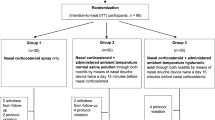Abstract
Saline nasal irrigation is effective in the treatment of seasonal allergic rhinitis, and sodium chloride itself has no antiallergic effects. The mechanism of saline nasal irrigation depends mainly on washing away allergens and inflammatory mediators induced by allergic reactions. Tap water has the same washing effects as saline. In this study, it was investigated if tap water nasal irrigation was effective in the treatment of seasonal allergic rhinitis. Sixty-four patients diagnosed with seasonal allergic rhinitis were enrolled. Patients were randomized to tap water nasal irrigation group and non-tap water nasal irrigation group for treatment. Patients of both groups were treated with desloratadine. Treatment outcomes were measured using allergic rhinitis Quality of Life (QoL) survey was completed at baseline and after 3 weeks of therapy. There were statistically significant differences in QoL scores between tap water nasal irrigation group and non-tap water nasal irrigation group. The tap water nasal irrigation group had better QoL scores than the non-tap water nasal irrigation group. Tap water nasal irrigation can be a valuable adjuvant therapy for patients with seasonal allergic rhinitis.
Similar content being viewed by others
References
Lukat K, Rivas P, Roger A, Kowalski M, Botzen U, Wessel F, Sanquer F, Agache I, Izquierdo I (2013) A direct comparison of efficacy between desloratadine and rupatadine in seasonal allergic rhinoconjunctivitis: a randomized, double-blind, placebo-controlled study. J Asthma Allergy 6:31–39
Parikh A, Scadding GK (1997) Seasonal allergic rhinitis. BMJ 314(7091):1392–1395
Tomooka LT, Murphy C, Davidson TM (2000) Clinical study and literature review of nasal irrigation. Laryngoscope 110(7):1189–1193
Ferguson BJ (1997) Allergic rhinitis. Options for pharmacotherapy and immunotherapy. Postgrad Med 101(5):117–120
Taccariello M, Parikh A, Darby Y, Scadding G (1999) Nasal douching as a valuable adjunct in the management of chronic rhinosinusitis. Rhinology 37(1):29–32
Parsons DS (1996) Chronic rhinosinusitis: a medical or surgical disease? Pediatr Sinusitis 29:1–9
Talbot AR, Herr TM, Parsons DS (1997) Mucociliary clearance and buffered hypertonic saline solution. Laryngoscope 107:500–503
Shoseyov D, Bibi H, Shai P, Shoseyov N, Shazberg G, Hurvitz H (1998) Treatment with hypertonic saline versus normal saline nasal wash of pediatric chronic sinusitis. J Allergy Clin Immunol 101:602–605
Garavello W, Romagnoli M, Sordo L, Gaini RM, Di Berardino C, Angrisano A (2003) Hypersaline nasal irrigation in children with symptomatic seasonal allergic rhinitis: a randomized study. Pediatr Allergy Immunol 14(2):140–143
Marchisio P, Varricchio A, Baggi E, Bianchini S, Capasso ME, Torretta S, Capaccio P, Gasparini C, Patria F, Esposito S, Principi N (2012) Hypertonic saline is more effective than normal saline in seasonal allergic rhinitis in children. Int J Immunopathol Pharmacol 25(3):721–730
Ponikau JU, Sherris DA, Kephart GM, Kern EB, Congdon DJ, Adolphson CR, Springett MJ, Gleich GJ, Kita H (2005) Striking deposition of toxic eosinophil major basic protein in mucus: implications for chronic rhinosinusitis. J Allergy Clin Immunol 116(2):362–369
Georgitis JW (1994) Nasal hyperthermia and simple irrigation for perennial rhinitis. Changes in inflammatory mediators. Chest 106(5):1487–1492
Talbot AR, Herr TM, Parsons DS (1997) Mucociliary clearance and buffered hypertonic saline solution. Laryngoscope 107(4):500–503
Boek WM, Graamans K, Natzijl H, van Rijk PP, Huizing EH (2002) Nasal mucociliary transport: new evidence for a key role of ciliary beat frequency. Laryngoscope 112(3):570–573
Krayenbuhl MC, Hudspith BN, Brostoff J, Scadding GK, Guesdon JL, Latchman Y (1989) Nasal histamine release following hyperosmolar and allergen challenge. Allergy 44:25–29
Baraniuk JN, Ali M, Yuta A, Fang SY, Naranch K (1999) Hypertonic saline nasal provocation stimulates nociceptive nerves, substance P release, and glandular mucous exocytosis in normal humans. Am J Respir Crit Care Med 160:655–662
Conflict of interest
The authors report no conflicts of interest. The authors alone are responsible for the content and writing of the paper.
Author information
Authors and Affiliations
Corresponding author
Rights and permissions
About this article
Cite this article
Xiong, M., Fu, X., Deng, W. et al. Tap water nasal irrigation in adults with seasonal allergic rhinitis: a randomized double-blind study. Eur Arch Otorhinolaryngol 271, 1549–1552 (2014). https://doi.org/10.1007/s00405-013-2741-4
Received:
Accepted:
Published:
Issue Date:
DOI: https://doi.org/10.1007/s00405-013-2741-4




